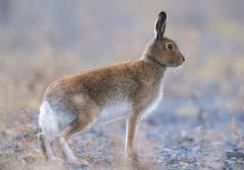17th October 2014.
Review
The seminar approached the question of whether the European hare Lepus europaeus, and its increasing prevalence in Ireland was in part responsible for the depleting population size of the distinct, endemic species of hare, the Irish mountain hare – Lepus timidus hibernicus, Irelands only endemic lagomorph species. Population estimates of the numbers of Irish mountain hare in 2007 predicted that there were less than 1 million individuals remaining. Conversely the population sizes of European hares have increased greatly over the past 5 years.


Other factors suspected to be responsible for the decline in population size of the Irish mountain hare is the increase in agricultural intensification and the homogenization of the landscape – which has lead to decreasing population sizes in Irish hares since 1970.
European hares have previously been recorded to have out-competed and as a consequence displaced the Mountain hare out of Sweden. The European hare has been known to transmit diseases to the Irish hare and their presence can help to exacerbate the effects of climate change by displacing the Irish hare to higher altitudes or differing terrains. Hybridization does occur naturally between populations, but the offspring are unidirectional in favour of the European hare.
In the experiment by Caravaggi and his team camera trapping and the random encounter model (REM) were used to monitor the population densities, these methods are favourable as they decrease observer impact and do not require the identification of individuals in a population.
Results from the monitoring techniques supports claims of direct displacement, especially within the center of the population.
Opinion
I found the seminar to be enjoyable and interesting and was delivered well by the speaker, I thought that the camera trapping technique was interesting in its application and the experiment incorporated and used key biological principles well and has important findings for conservation techniques.
Career
Despite me finding the subject interesting I would not like to go down this route in my career, as I would prefer to extend and further my techniques and interest in the field of micro and molecular biology.
